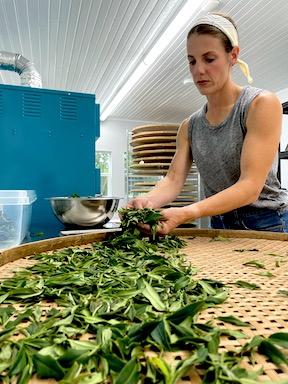
In 2011, Thomas Steinwinder was sitting in a Shanghai, China café drinking a cup of tea when he was asked, “Where do you grow tea in the U.S.?” Steinwinder told the questioner that the U.S. imports most of its tea, but he didn’t have an answer as to why the U.S. doesn’t grow its own tea.
After he returned to the U.S., he and his wife, Hillary, began researching tea plant growing. That research eventually led to them launching Longleaf Tea Company on southeast Mississippi farmland that’s been in Hillary’s family for 5 generations.
“We spent seven years researching tea farming, processing, climate requirements, and market needs,” Steinwinder says. “We planted 1,200 plants in October 2018, another 1,000 in 2019, and now have more than 3,000 plants in the ground.”
Steinwinder says growing tea plants requires four key ingredients. They need acidic soil that’s well-drained, at least 50 in. of rainfall per year, and lots of sunshine. Their farm location at Laurel, Miss. satisfies all four requirements.
Longleaf’s tea plants are coupled in rows that gradually form into thick hedges. Tulip Poplar trees are planted among the rows to provide the mottled shade that tea plants require.
Most of the world’s tea, whether it’s black, oolong, white or green, is produced from the tea plant Camellia sinensis. Tea leaves are harvested every two weeks from March to October by “hand plucking” just the top two leaves and a leaf bud on new growth. Black tea is processed from leaves that are withered, or left to wilt for several hours, then rolled to bruise the leaves. The bruising releases enzymes that oxidize compounds in the leaf tissue, causing leaves to turn dark brown. With green tea, leaves are steamed after a short withering step.
Although most of the world’s tea is still plucked by hand, mechanical harvesters are making inroads. Steinwinder says he will begin experimenting in 2023 with an Australian harvesting system that mimics hand plucking. He and his wife envision their tea plantation becoming an “agro-tourism” stop in the future for people willing to pay to visit a tea plantation.
Asked his advice for people who might want to start a growing tea, Steinwinder says, “Because of the capital outlay and huge time commitment, you’ll feel like you want to quit for the first three or four years. We went through all that, and now that the plants are maturing and our internet orders are growing, it’s becoming a really fascinating enterprise.”
Contact: FARM SHOW Followup, Long Leaf Tea Company, Laurel, Miss. (www.longleaftea.co).
